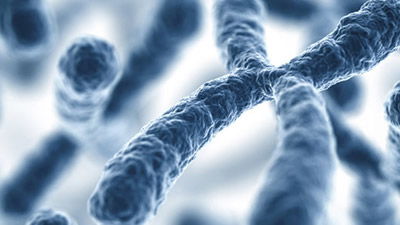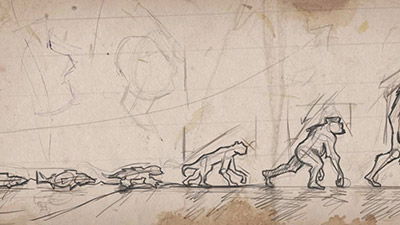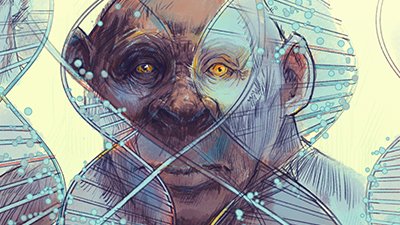Dragon Man, the Newest Human “Cousin”?
Evolutionists suggest Chinese “Dragon Man” is a 100,000-year-old hominid while biblical creationists understand discovery in light of post-Babel dispersion
In 1933, as the story goes, a forced labor worker who was helping build a bridge over the Songhua River in Harbin, Heilongjiang Province, China, found a skull partially buried in river sediment. Not wanting it to fall into the hands of the occupying Imperial Japanese soldiers, he buried it in a well, telling his grandchildren about it on his deathbed. They retrieved it in 2018 and donated it to the Geoscience Museum at Hebei GEO University. This skull came to be known as the Harbin skull, or Homo longi, also dubbed as the “Dragon man.”
Before researchers could question the elderly man about where exactly he’d found the skull, he had passed away. However, a general location could be determined. Griffith University geochronologist Rainer Grün and colleagues found some sediment encrusted in the nasal cavities of the skull, which they linked via strontium isotope testing to a specific layer of sediments around the bridge. This yielded a date between 138,000 and 309,000 years ago. Uranium series disequilibrium (or U-Th dating) on the bone placed it a minimum age of 146,000 years.1 But as mentioned many times on our website, there are many assumptions built into radiometric dating and radioisotope isochron dating methods. Compared against known dates, the dates yielded are faulty. This skull, in reality, belongs to a post-Babel human, roughly between 2200–1800 BC.
Neanderthal, Denisovan, or a New Human “Sister-Species”?
Comparing the skull to other Chinese finds, the closest match for the upper jaw of the Harbin skull with a corresponding size was the Denisovan lower jawbone of Baishiya Karst Cave in Xiahe on the Tibetan Plateau, yet the date yielded from the Denisovan jawbone was slightly older, dated from 160,000–170,000 years. But dates for Denisovan fossils found in Denisova Cave, Russia, range from 54,000–99,000 years for the oldest down to 30,000–50,000 years for the youngest. But the Chinese Denisovans are claimed to be descendants of the Russian Denisovans. Consequently, evolutionists must paint a picture of waves of migration from Russia to Tibet for presumed older Denisovans which haven’t been found yet.
The eye sockets are larger and more square than typical Neanderthal skulls, with the closest analogs being H. heidelbergensis and modern humans, although the Harbin skulls are larger and more square-shaped.
But the Harbin skull and its back molar of the upper jaw (the lower jaw was not found with the skull) tell a conflicting story. The molar is quite large and very closely resembles that of another molar found in the Denisovan jawbone in Baishiya Karst Cave. But the pronounced brow ridges of the skull are much more reminiscent of Neanderthal skulls. However, there is no protruding occipital region (a “bulbous bump” on the back base of the skull) or suprainiac fossa (a depression on the external surface of the occipital bone located just above the base of the skull), which is generally described as a “transversely elongated structure, elliptical in shape, with a rough or pocked surface” (basically a horizontal crevice or series of pits inside an oval depression on the back bottom of the skull), both of which (the protrusion and the depression within that protrusion) are characteristic of practically every Neanderthal skull ever found.2 And though pronounced brow ridges can still be found in modern humans as well, they are typically considered to be a characteristic of Neanderthals.
The eye sockets are larger and more square than typical Neanderthal skulls, with the closest analogs being H. heidelbergensis and modern humans, although the Harbin skulls are larger and more square shaped. The brain size is estimated to be in the range of modern humans and Neanderthals, but the face is much wider (as is the mouth, though that can only be estimated since the lower jaw is missing). The cheekbones are higher than most modern humans, yet the overall size and shape of the skull most closely match a Homo sapiens skull found in Morocco, which is dated to 300,000 BP. Consequently, the researchers are left with a specimen with a Denisovan tooth and Neanderthal brow ridges, but a skull closer to a H. sapiens skull dated over 150,000 years older. It’s no wonder that without DNA testing (as of this writing), the researchers, using over 90 cranial data sets and several phylogenetic analyses, decided to claim that the Harbin skull belongs to a new human species—a sister species to modern humans, dubbed H. longi by some members of the research team and by the press.
The Harbin cranium is one of the best preserved of all archaic human fossils and its estimated late Middle Pleistocene age places it as an Asian contemporary of the evolving H. sapiens, H. neanderthalensis, and Denisovan lineages. It is huge in size, and its distinctive combination of traits in the cranial vault and face differentiate it from H. sapiens and H. neanderthalensis, as well as from the earlier species H. heidelbergensis/H. rhodesiensis. Instead, it shows the greatest resemblances to Middle Pleistocene Chinese fossils, such as Hualongdong, Dali, and Jinniushan. This is confirmed by phylogenetic analyses using parsimony and Bayesian methods, which place these Chinese fossils with Harbin as a part of the sister group to H. sapiens.3
Can’t We All Get a longi?
But not all the researchers of the study agreed with the first paper’s conclusion (quoted above) that both the Dali and Hualongdong crania should be grouped with H. longi.
But not all the researchers of the study agreed with the first paper’s conclusion (quoted above) that both the Dali and Hualongdong crania should be grouped with H. longi. It appeared that the deal-breaker for them was the Denisovan-like tooth in H. longi and the fact that the Dali and Hualongdong skulls showed great similarity to each other and much less so to the Harbin and Jinniushan skulls, which they accept as both belonging to H. longi. So, four of the researchers of the first paper proposed in another paper in the same journal that those two should be grouped into their own species, H. daliensis.4
But another member of the research team, Chris Stringer from the National History Museum in London and one of the contributing authors of the first paper, has yet another view. He agrees that Dragon Man deserves a distinct species name, but he thinks the skull might also be linked to the Dali skull, also found in China. CNET reports his saying, "I would prefer to place the Harbin and Dali fossils together as (Homo) daliensis. I also consider Harbin as a possible Denisovan, although much more work is needed there.”5
And several other researchers not involved with the study want to ditch H. longi altogether, as they firmly believe the skull is Denisovan or the designation too premature. Paleoanthropologist Jean-Jacques Hublin of the Max Planck Institute for Evolutionary Anthropology said, “It’s a wonderful skull; I think it’s the best skull of a Denisovan that we’ll ever have” and Bence Viola, a paleoanthropologist at the University of Toronto is anticipating that future DNA analysis of the skull will allow him to “look into the eyes of a Denisovan.”6 Paleoanthropologist Marta Mirazón Lahr of the University of Cambridge claimed she was “skeptical of the statements about humans’ long-lost sister lineage,” and María Martinón-Torres, a paleoanthropologist at the national center for research on human evolution in Spain, stated, “It’s premature to name a new species, especially a fossil with no context, with contradictions in the data set.”7
Lots of Measurements and Lots of Storytelling
The researchers were definitely thorough in their measurements, using over 90 sets of data from a skull with no lower jawbone. It seems that every conceivable angle between one bone or aperture and the next was measured and compared to other Neanderthal, H. erectus, and other supposed human ancestor skulls. Since no DNA was taken from the Harbin skull, for fear of damaging it, they were left with basically a comparative morphology exercise with phylogenetics thrown into the mix.
While there was intricate observational science performed on the skull, the conclusions were drawn from preconceived notions of supposed human evolutionary ancestry.
While there was intricate observational science performed on the skull, the conclusions were drawn from preconceived notions of supposed human evolutionary ancestry. Perhaps this explains why the data sets were contested and several hypotheses formulated on where this skull fits in the evolutionary paradigm. However, it must be noted that there is a wide range in skull shape in modern humans. There are humans with skulls just as large, with a mouth just as large as the estimation of the Harbin skull and with cheekbones as high and faces as flat. All those measurements fall within modern human variation.
The lack of a protruding occipital region and suprainiac fossa likely does not make the skull a Neanderthal. If those are indeed characteristic of every Neanderthal skull found, then it is likely that the post-Babel people group who migrated into Europe and parts of (mostly western) Asia had that as a defining (or at least prevalent) genetic trait. It should be no surprise then that other people groups would not have had these traits. And since no complete Denisovan skull has been documented, the brow ridges may have been not just diagnostic for Neanderthals, but Denisovans as well. Keeping in mind that Denisovans and Neanderthals had children together, which is not surprising at all since both are fully human, the Harbin skull could also be showing a mix of traits from the post-Babel Denisovan and Neanderthal people groups. This could easily account for all the differing characteristics found in this skull. While the researchers can be applauded for their commitment to accurate measurements, to postulate a “sister human species” from those measurements is nothing more than evolutionary storytelling.
Where Does Dragon Man Fit?
As people dispersed from Babel after God confused the language (Genesis 11:8–9), different people groups migrated all over Africa, Europe, and Asia. Some would have taken certain dominant genetic traits with them, which due to founder effect and genetic drift can become magnified.8 In addition, natural selection acting on environmental conditions or dietary restrictions would have also winnowed genetic variety and brought certain characteristics to the forefront.
Dragon Man is a post-Babel human, perhaps of the Denisovan people group, or perhaps a result of intermarriage between post-Babel Denisovans and Neanderthals.
Neanderthals, Denisovans, and other supposed human “cousins,” including this Harbin skull, are just humans, some with prevailing characteristics (like brow ridges) that we associate with that specific people group (in this case Neanderthals). However, modern humans have a huge variation in physical appearance and even skeletal differences. Brow ridges can still be seen in modern humans, especially prevalent in those with eastern European ancestry.9
Dragon Man is a post-Babel human, perhaps of the Denisovan people group, or perhaps a result of intermarriage between post-Babel Denisovans and Neanderthals. Or perhaps he is only distantly related to those groups. In any case, he was just as human as you and me. But we know that he was human, was created in God’s image (Genesis 1:28), and is not some evolutionary sidebar to modern humans.
Footnotes
- Qingfeng Shao, et. al., “Geochemical Provenancing and Direct Dating of the Harbin Archaic Human Cranium,” The Innovation, June 25, 2021, https://www.cell.com/the-innovation/fulltext/S2666-6758(21)00056-4.
- Antoine Balzeau and Hélène Rougier, “Is the Suprainiac Fossa a Neandertal Autapomorphy? A Complementary External and Internal Investigation,” Journal of Human Evolution 58 (1), (January 2010): 1–22, https://www.sciencedirect.com/science/article/abs/pii/S0047248409001481.
- Xijun Ni, et. al., “Massive Cranium from Harbin in Northeastern China Establishes a New Middle Pleistocene Human Lineage,” The Innovation, June 25, 2021, https://www.cell.com/the-innovation/fulltext/S2666-6758(21)00055-2.
- Qiang Ji, et. al., “Late Middle Pleistocene Harbin Cranium Represents a New Homo Species,” The Innovation, June 25, 2021, https://www.cell.com/the-innovation/fulltext/S2666-6758(21)00057-6.
- Eric Mack, “Dragon Man Skull Dumbfounds, Digs Up Doubts about Human Evolution,” CNET, last modified June 30, 2021, https://www.cnet.com/news/dragon-man-skull-dumbfounds-digs-up-doubts-about-human-evolution/.
- Ann Gibbons, “Stunning ‘Dragon Man’ Skull May Be an Elusive Denisovan—or a New Species of Human,” Science, June 25, 2021, https://www.sciencemag.org/news/2021/06/stunning-dragon-man-skull-may-be-elusive-denisovan-or-new-species-human.
- Gibbons, “‘Dragon Man’ Skull.”
- In discussing potential changes in human traits over time, Dr. Elizabeth Mitchell has said, “Genetic drift is the result of the simple probability that in each generation some individuals by chance leave behind more descendants than others. Those individuals’ genes, therefore, are more highly represented in the later populations without any regard to fitness for survival. Founder effect is the result of a genetic bottleneck, such as occurs when a small portion of a population is segregated and then reproduces with decreased genetic variability,” https://answersingenesis.org/human-evolution/evidence-continuing-human-evolution-arguably-irrelevant/
- For example, see this picture of former Russian Boxer Nicolay (or Nicolai) Valuev https://commons.wikimedia.org/wiki/File:Nikolay_Valuev_2018.jpg.

Answers in Genesis is an apologetics ministry, dedicated to helping Christians defend their faith and proclaim the good news of Jesus Christ.
- Customer Service 800.778.3390
- Available Monday–Friday | 9 AM–5 PM ET
- © 2025 Answers in Genesis




